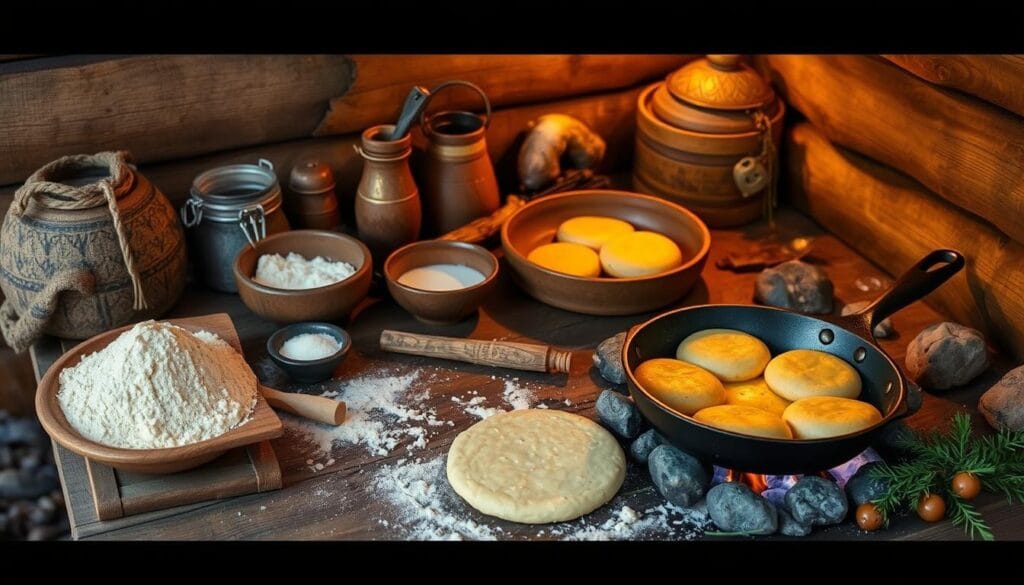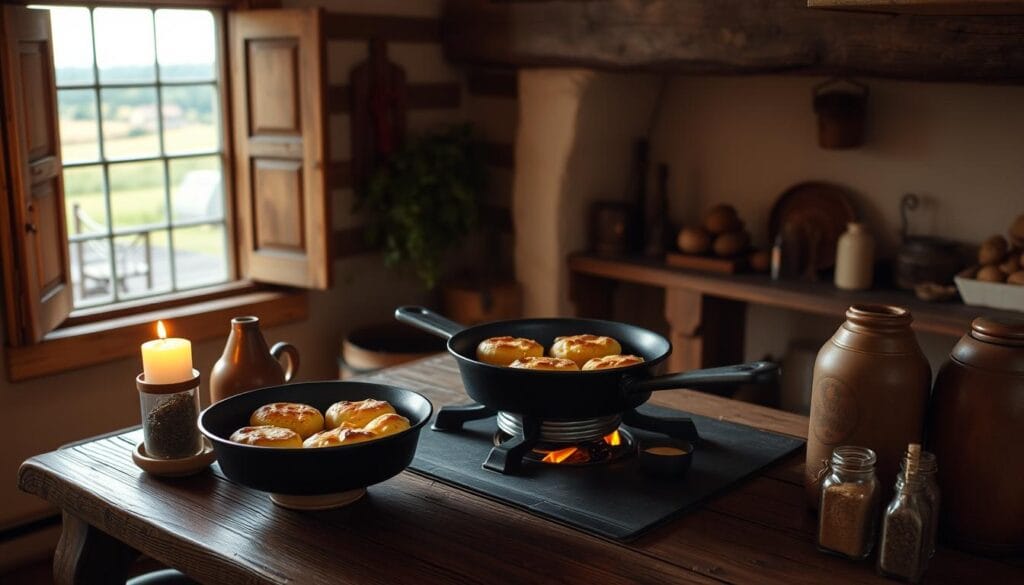Growing up in Rhode Island, my grandmother’s kitchen was always filled with the sound of sizzling cornmeal flatbread. It took me back to our family’s deep culinary roots. Johnny cakes, those golden, crispy treats, were more than just food. They connected us to our Native American johnnycakes tradition, passed down through generations.
Johny Cakes are more than just a breakfast food. They hold a centuries-old cultural history, blending indigenous cooking with modern American tastes. Whether they’re thin and crisp or thick and hearty, these flatbreads have fed and delighted people for ages.
From Native American kitchens to colonial tables, They have been a favorite for centuries. They tell a story of resilience, adaptation, and creativity in cooking. Made from simple ingredients like cornmeal and water, they have a rich and captivating history that still excites food lovers today.
Table of Contents
Key Takeaways
- Johnny cakes are a traditional Native American cornmeal flatbread
- They represent an important part of indigenous culinary heritage
- The dish has evolved through centuries of American cooking
- Simple ingredients create a versatile and delicious food
- Johnny cakes connect modern diners to historical food traditions
Understanding Johnny Cakes: A Traditional Native American Staple
They are a key part of indigenous cuisine, with roots in Native American cooking. These cornmeal flatbreads have fed generations, linking communities through food.

The tale of johnny cakes starts with Native Americans and their use of ground corn. They turned simple ingredients into meals that lasted in tough times.
Origins in Indigenous Cuisine
Native American johnnycakes come from a deep understanding of local foods and survival. Tribes in different areas made their own versions, using what was available and how they cooked.
- Originated with Native American tribes in Northeast regions
- Created as a portable, nutritious food source
- Used primarily ground corn as the main ingredient
Basic Components and Characteristics
Traditional johnny cakes are made with cornmeal, water, and sometimes salt. Their simplicity made them a quick and easy food to make.
“A food so simple, yet so profound in its cultural significance” – Native American Food Historian
Cultural Significance
Johnny cakes were more than food. They showed community strength, sharing, and the bond between people and land. Each cake had a story of survival, adaptation, and keeping culture alive.
- Represented community sharing practices
- Demonstrated agricultural knowledge
- Preserved cultural cooking traditions
The History and Evolution of Johnny Cakes Through Colonial Times
Johnny cakes became a key dish in New England during the colonial era. Early settlers took to this cornmeal-based food from Native American traditions. This change shows the cultural exchange between Native Americans and European settlers.

The roots of johnny cakes go back to Native American cooking. Indigenous groups made flatbreads from ground corn, a vital food. European colonists adopted these methods, adding them to their own recipes.
- Native Americans first developed cornmeal flatbreads
- Settlers adapted indigenous cooking techniques
- Hoecakes became a staple in early American settlements
Different areas had their own ways of making johnny cakes. In New England, they used stone-ground cornmeal and cooked on griddles or hot stones. The name “johnny cake” likely evolved from “journey cake,” showing its role as a travel food.
“A simple food that sustained generations, johnny cakes represent more than just a meal—they are a testament to culinary adaptation and survival.” – Historical Food Historian
By the late 18th century, johnny cakes were a staple in New England. Families made them for all meals, showing the dish’s versatility. The recipe spread, with each region adding its own twist.
Essential Ingredients for Authentic Johnny Cakes
Making the perfect Rhode Island johnnycakes begins with knowing the key ingredients. These ingredients are what make this traditional cornmeal flatbread special. The right mix can turn a simple recipe into a tasty treat.
Choosing the Right Cornmeal
The heart of authentic johnny cakes is the cornmeal. Not all cornmeal is the same for this classic dish.
- Stone-ground white cornmeal offers the most authentic flavor
- Finely ground cornmeal creates a smoother texture
- Coarse-ground cornmeal provides a more rustic feel
Basic Ingredients You’ll Need
A traditional johnny cake recipe needs just a few simple ingredients:
| Ingredient | Purpose | Recommended Quantity |
|---|---|---|
| Stone-ground cornmeal | Primary base | 1 cup |
| Salt | Flavor enhancement | 1/2 teaspoon |
| Boiling water | Binding ingredient | 1 cup |
Optional Flavor Enhancers
While some stick to traditional ingredients, you can try these flavor boosters:
- A pinch of sugar for subtle sweetness
- Melted butter for richness
- Milk as an alternative to water
- Fresh herbs for a savory twist
“The magic of johnny cakes is in their simplicity and the quality of ingredients.” – New England Culinary Tradition
The secret to perfect Rhode Island johnnycakes is using high-quality, fresh ingredients. Also, following the traditional preparation method is key. Your cornmeal flatbread will taste best when you focus on each ingredient.
Regional Variations Across New England
New England cuisine is rich and diverse. For instance, Rhode Island johnnycakes are a tasty example of this. Moreover, each state has its own special way of making these cornmeal treats.
In particular, Rhode Island johnnycakes are the most traditional. They use special white cornmeal, which makes thin, crispy pancakes that truly represent New England’s culinary heart.
For example:
- Rhode Island: Thin, crisp johnnycakes made with white cornmeal
- Massachusetts: Slightly thicker cakes with a heartier texture
- Connecticut: Often served with maple syrup as a sweet breakfast option
- Vermont: Incorporate local maple ingredients for added flavor
Similarly, in Massachusetts, johnnycakes are thicker and more filling. Chefs often mix white and yellow cornmeal. As a result, this blend honors Native American cooking traditions while also catering to modern tastes.
“Every region tells a story through its johnnycakes, preserving culinary heritage one bite at a time.” – Local New England Food Historian
Connecticut and Vermont have their own ways of making johnnycakes. In Connecticut, they’re a breakfast favorite with maple syrup. Vermont bakers add local maple to the batter.
But Rhode Island johnnycakes are still the truest to their roots. They keep the closest connection to the dish’s origins.
How to Make Traditional Rhode Island Johnny cakes
Making Rhode Island johnnycakes is an art that needs skill and care. These crispy cornmeal griddle cakes are a treasured part of New England’s food history.
To make perfect johnnycakes, you must know the key techniques and ingredients. These are what make these griddle cakes truly special.
Preparation Steps
To make delicious Rhode Island johnnycakes, start with the right ingredients and mixing. Here are the key steps:
- Choose high-quality stone-ground white cornmeal
- Mix cornmeal with boiling water to get a smooth batter
- Let the batter rest for 10-15 minutes to hydrate properly
- Adjust the batter’s consistency with water if needed
Cooking Techniques
Getting the cooking right is key for crispy, golden johnnycakes:
- Heat a cast-iron griddle or skillet to medium-high
- Lightly grease the griddle with butter or oil
- Pour small amounts of batter to make thin, round cakes
- Cook until the edges are golden brown (about 2-3 minutes per side)
Learn how to prepare homemade brined chicken or bake flavorful bone-in chicken.
Common Mistakes to Avoid
Avoid these common mistakes to ensure great results:
- Don’t overmix the batter, or the johnnycakes will be tough
- Use the right type of cornmeal
- Cook at the right temperature
- Give the batter enough resting time
“The secret to perfect Rhode Island johnnycakes lies in patience and practice.” – Traditional New England Cook
| Ingredient | Quantity | Purpose |
|---|---|---|
| White Cornmeal | 1 cup | Primary base |
| Boiling Water | 1/2 cup | Hydration and binding |
| Salt | 1/4 teaspoon | Flavor enhancement |
With practice, you’ll master making authentic Rhode Island johnnycakes. They’ll capture the essence of this beloved regional treat.
Johnny Cakes vs. Other Cornmeal-Based Foods
Exploring traditional cornmeal dishes, johnny cakes stand out. They differ from cornbread pancakes and hoecakes. Each dish has its own unique taste and cooking method.
Let’s look at what makes johnny cakes different from other cornmeal flatbreads:
- Texture: Johnny cakes are thinner and crisper than cornbread pancakes
- Ingredients: Hoecakes may have extra flour, but johnny cakes stick to cornmeal
- Cooking method: They’re griddle-cooked, giving a crispy outside
Regional cooking styles make cornmeal flatbreads vary. Rhode Island’s johnny cakes, for example, use stone-ground white cornmeal. This gives them a light, unique taste that’s different from thicker cornbread.
“A true johnny cake is more than a recipe—it’s a culinary tradition passed through generations.” – Traditional New England Cook
Choosing between johnny cakes, cornbread pancakes, or hoecakes is up to you. It depends on what you like and where you’re from. Each dish gives a taste of America’s rich food history.
Serving Suggestions and Traditional Accompaniments
Johnny cakes from New England cuisine are perfect for both sweet and savory dishes. These cornmeal pancakes can make your meal special with the right toppings.
Sweet Toppings and Combinations
Try these sweet options to make johnny cakes a treat:
- Maple syrup from Vermont’s finest producers
- Fresh local berries
- Honey drizzle
- Whipped cream
- Fruit compotes
Savory Serving Ideas
For those who love hearty flavors, johnny cakes go great with savory ingredients:
- Crispy bacon strips
- Scrambled eggs
- Smoked salmon
- Pulled pork
- Butter and chives
| Serving Style | Recommended Toppings | Best Time to Serve |
|---|---|---|
| Breakfast | Maple syrup, butter | Morning |
| Lunch | Pulled pork, coleslaw | Midday |
| Dinner | Smoked salmon, crème fraîche | Evening |
“Johnny cakes are not just a food, they’re a culinary tradition that connects us to New England’s rich gastronomic heritage.” – Local Rhode Island Chef
Try these ideas to find your favorite way to enjoy johnny cakes. Whether you like them sweet or savory, these pancakes will surely please your taste buds.
Modern Adaptations and Creative Recipes
They have grown beyond their old days, and as a result, they are sparking new ideas in kitchens everywhere. Nowadays, they’re found in fancy restaurants and cool homes across the U.S.
Interestingly, today’s chefs are adding fresh twists to johnny cakes. They keep the classic taste, but at the same time, they add exciting new flavors. Consequently, this makes the traditional cornmeal pancake truly special.
For instance:
Breakfast Fusion Versions:
- Topped with avocado and poached eggs
- Served with maple-glazed bacon
- Incorporated into breakfast sandwich designs
In contrast, there are also gourmet savory variations:
- Truffle-infused cornbread pancakes
- Herb-crusted johnny cakes with goat cheese
- Spicy southwestern-style preparations
Additionally, restaurant chefs are mixing things up with johnny cakes. As such, they’re turning these old-time treats into fancy dishes. Moreover, you can make your own version by adding things like:
- Fresh herbs
- Exotic spices
- Artisanal cheeses
- Locally sourced vegetables
“Johnny cakes represent a delicious canvas for culinary creativity, bridging traditional techniques with modern gastronomy.” – Chef Michael Rodriguez
Whether you’re a pro chef or just cooking at home, they offer a chance to mix old and new. They show how cornbread pancakes can spark creativity in many cuisines.
Conclusion
They are more than just a simple cornmeal flatbread. They connect us to North America’s indigenous cuisine. Exploring this dish, you’ll find a tasty link to historical cooking traditions.
Making them in your kitchen lets you taste culinary history. You can try the traditional Rhode Island recipe or explore regional twists. These cornmeal flatbreads are easy to make and perfect for all cooks.
Your cooking adventure doesn’t stop with a basic recipe. Every time you make johnny cakes, you help keep American food history alive. They can be sweet breakfast treats or savory side dishes, adding variety to your meals.
They are a testament to Native American cooking’s ingenuity. By making and sharing these flatbreads, you keep a cultural tradition alive for others to enjoy.
FAQs
What exactly are johnny cakes?
They are a traditional Native American cornmeal flatbread. They are thin pancakes made from ground corn, water, and sometimes salt. This simple dish has been a staple in Native American and early American cuisine, especially in New England.
How do johnny cakes differ from regular pancakes?
Unlike wheat flour pancakes, johnny cakes are made from cornmeal. This gives them a unique texture and flavor. They are flatter, crisper, and have a rustic look. The cornmeal adds a grainy texture and a robust corn flavor.
Are johnny cakes the same as hoecakes?
While similar, they’re not the same. Hoecakes come from African American traditions and were cooked on a hoe over an open fire. They are more tied to Native American and New England cuisine, but both are cornmeal-based flatbreads.
What type of cornmeal works best for johnny cakes?
Stone-ground cornmeal is best for authentic johnny cakes. It gives a traditional texture and flavor. Fine-ground cornmeal can make the cakes smoother, but they won’t be as rustic. Rhode Island-style johnny cakes use white cornmeal for a lighter, more delicate flatbread.
Can johnny cakes be served sweet or savory?
Absolutely! Johnny cakes are versatile. You can enjoy them sweet with maple syrup, honey, or fruit compote. Or, you can have them savory with butter, seafood, eggs, or as a side to main dishes. In New England, they’re often enjoyed with both sweet and savory toppings.
Are johnny cakes gluten-free?
Yes, traditional johnny cakes are gluten-free because they’re made from cornmeal. However, always check your ingredients to avoid cross-contamination if you have gluten sensitivity or celiac disease.
How long have johnny cakes been part of American cuisine?
Johnny cakes have a long history, dating back to Native American times. They were a key food source for indigenous communities and later adopted by colonial settlers. This makes them one of the oldest continuous food traditions in North America, spanning hundreds of years.
What’s the best way to cook johnny cakes?
The traditional method is cooking them on a griddle or cast-iron skillet. Use medium heat to make a thin, crispy cake with a golden-brown exterior. The key is to use just enough batter for a thin pancake and cook until edges are crisp and the surface is set.
Can I make johnny cakes ahead of time?
Yes, you can prepare the batter in advance and store it in the refrigerator for 1-2 days. However, they’re best served fresh and hot right off the griddle. If reheating, a quick warm-up in a skillet can help restore their crispy texture.
Are johnny cakes nutritious?
Cornmeal provides several nutritional benefits. Johnny cakes are a good source of complex carbohydrates, contain some protein, and offer minerals like magnesium and phosphorus. However, their nutritional value can vary based on additional ingredients and preparation method.

